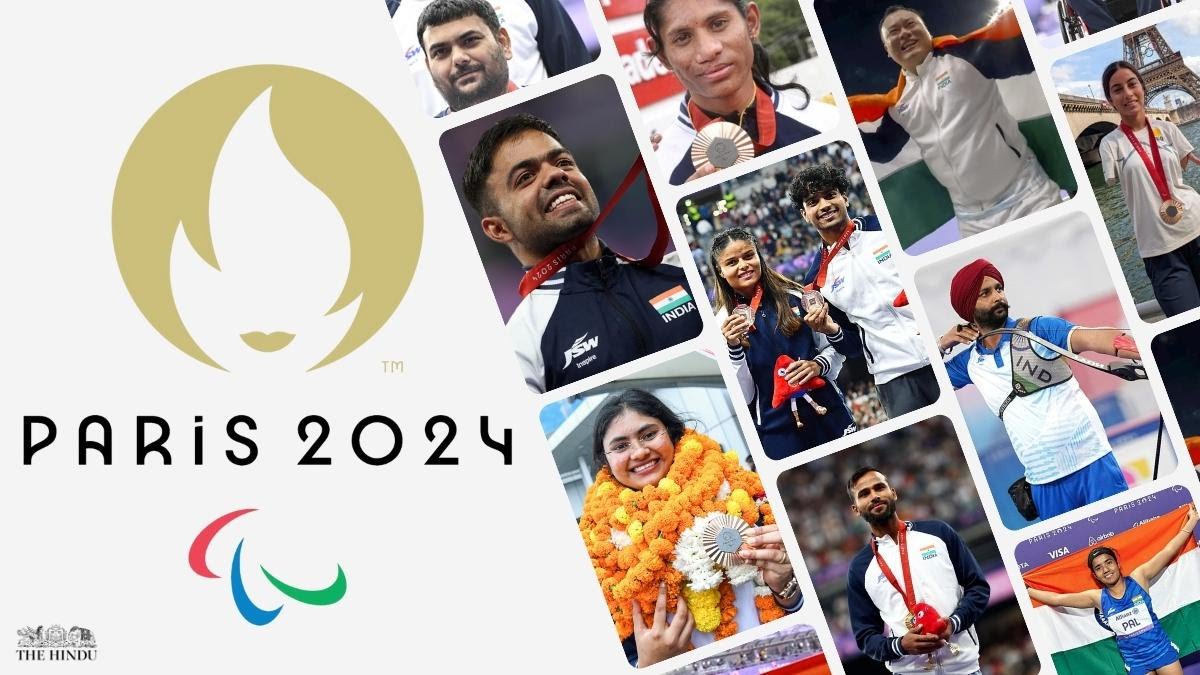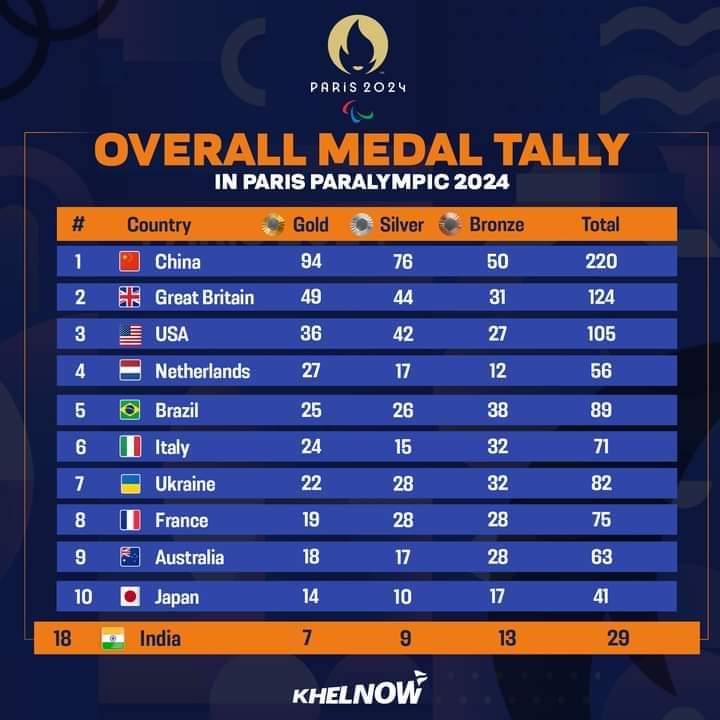 |
| Credit- The Hindu |
#) Introduction:
The Paralympic Games are more than just a sports event; they are a powerful force for change. Starting as a small event for injured soldiers after World War II, the Paralympics have grown into a major international competition. These games show the incredible abilities of athletes with disabilities and help change how society views disability. They promote inclusion and inspire millions of people around the world. This article will explore how the Paralympic Games impact society, share stories of amazing athletes, discuss new sports technologies, and look at the ongoing efforts to create a more inclusive world.
#) Historical context:
The Paralympic Games began in 1948 with the Stoke Mandeville Games, organized by Dr. Ludwig Guttmann for World War II veterans with spinal injuries. This event, featuring 16 athletes, marked the start of using sports for rehabilitation.
In 1960, the first official Paralympic Games were held in Rome, Italy, with 400 athletes from 23 countries. The Games continued to grow, including the first Winter Paralympics in 1976.
Since 1988, the Paralympics have been held in the same cities and venues as the Olympics, thanks to an agreement between the International Paralympic Committee (IPC) and the International Olympic Committee (IOC). Today, the Paralympics are a major international event, promoting inclusivity and challenging perceptions of disability.
India’s Participation and First Winner; India first participated in the Paralympic Games in 1968. The country’s first Paralympic medal came in the 1972 Games when Murlikant Petkar won a gold medal in the men’s 50-meter freestyle swimming event.This victory marked a significant milestone for India in the Paralympic movement.
#) Social Impact:
The Paralympic Games have significantly influenced societal attitudes towards disability and inclusivity by:
● Changing Perceptions: Highlighting the abilities of athletes with disabilities, shifting views from limitations to capabilities.
● Promoting Inclusivity: Leading to improved accessibility and inclusivity in host countries.
● Raising Awareness: Increasing public understanding and respect through extensive media coverage.
● Legislative Changes: Acting as a catalyst for new laws and policies benefiting people with disabilities.
● Social and Economic Benefits: Enhancing social security, employment, and education opportunities for disabled individuals.
#) Athlete Stories:
Global
Paralympic Athletes:
● Jessica Long (USA): Overcame leg amputations to win 23 Paralympic medals in swimming.
● Melissa Stockwell (USA): Former soldier turned Paralympic triathlete after losing her leg in combat.
● Matt Scott (USA): Four-time Paralympian in wheelchair basketball, known for his remarkable recovery from illness.
Indian
Paralympic Athletes
● Devendra Jhajharia: Two-time gold medalist in javelin throw, despite losing his left arm.
● Deepa Malik: First Indian woman to win a Paralympic medal (silver in shot put), paralyzed from the waist down.
● Mariyappan Thangavelu: Gold medalist in high jump, lost his right leg in an accident at age five.
These athletes have not only excelled in their sports but also inspired many by breaking barriers and advocating for disability rights.
#) Technological Advancements:
● Prosthetics and Orthotics: Modern prosthetics, like carbon fiber running blades, enhance speed and agility for amputee athletes.
● Wheelchair Technology: Customized sports wheelchairs improve mobility and performance in sports like basketball and racing.
● Assistive Devices: Specialized equipment, such as release braces in archery, aid athletes with limited mobility.
● Smart Wearable: Devices like sensors and smartwatches provide real-time performance data, optimizing training and preventing injuries.
● VR and AR: These technologies create immersive training environments, helping athletes simulate real-world scenarios.
● Inclusive Design: Ensures sports facilities and equipment are accessible to all, promoting inclusivity and breaking down barriers.
These advancements not only boost athletic performance but also enhance the overall experience for Paralympic athletes.
#) Future Prospects:
The future of the Paralympic movement is bright, with several opportunities and challenges ahead:
Opportunities
● Increased Visibility: Growing global viewership helps challenge stereotypes and promote inclusivity.
● Technological Advancements: Innovations in assistive technologies enhance athlete performance and daily life for people with disabilities.
● Policy Influence: The Games drive policy changes and advocacy for accessibility and rights.
● Grassroots Development: Investment in local sports programs nurtures future athletes and promotes inclusivity.
Challenges
● Funding: Limited financial support for athletes and programs.
● Accessibility: Ongoing barriers in sports facilities and public spaces.
● Representation: Need for balanced media portrayal of athletes.
● Sustainability: Ensuring long-term investments and environmental responsibility.
By addressing these challenges and leveraging opportunities, the Paralympic movement can continue to inspire and empower people with disabilities worldwide.
The Paris Paralympic Games 2024 are set to be a
landmark event, showcasing the incredible talents of athletes with disabilities
from around the world. Scheduled to take place from August 28 to September 8,
2024, these Games will feature 22 sports, including new additions like
Para-taekwondo and Para-badminton.
 |
| source- X |
Athletes and Indian Achievements
The Paris 2024 Paralympics will see participation from top athletes globally, including a strong contingent from India. India has achieved its best-ever performance at these Games, securing a total of 29 medals - seven gold, nine silver, and 13 bronze.
Notable Indian
Winners:
● Avani Lekhara: Defends her title in the women’s 10m air rifle standing SH1 shooting event, setting a world record.
● Sumit Antil: Won gold in the men’s javelin throw F64, breaking his own Paralympic record multiple times.
● Dharambir: Clinched gold in the men’s club throw F51, setting a new Asian record.
● Preethi Pal: Secured bronze in the women’s 100m T35 race and another bronze in the 200m, making her India’s most successful athlete at the Games.
● Sheetal Devi: Became India’s youngest Paralympic medalist at 17, winning bronze in the mixed team archery event.
These achievements highlight the exceptional talent and determination of Indian para-athletes, contributing to a historic performance for the country at the Paris Paralympics.
In essence, the Paris 2024 Paralympics promise to be a celebration of athletic excellence and a powerful platform for social change, driving forward the message of inclusivity and equality.
Team
Yuva Aaveg
Praveen
Kumar Maurya


.png)






